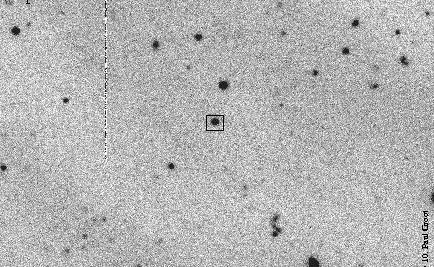
|
Credit: P. J. Groot et al.
U. Amsterdam
Explanation:
The GRB distance scale controversy
may have just ended with a flash.
Gamma Ray Bursts (GRBs)
are powerful explosions occurring in seemingly random positions on the sky.
They are so featureless and so poorly resolved,
however, that their distances could not be determined.
Last Thursday, May 8th, the orbiting
Beppo-Sax Satellite
detected and precisely located a GRB (GRB970508),
quickly relaying its position to astronomers.
Within hours, many of the
world's most powerful telescopes
were re-pointed in the direction of the new GRB.
There they found a faint but variable optical source:
a potential counterpart to the gamma-ray burst that was getting brighter.
Most importantly, continued scrutiny showed that this
optical transient
had absorption lines with a
redshift of about 0.8 - the distance scale of
galaxies and
quasars.
If this source and GRB970508 are related, the GRB itself must be
many billions of light-years away and the
30-year controversy on the distance scale to GRBs will draw
dramatically to a close. GRBs could move from the realm of
astronomical mystery to useful beacons of the early universe.
Above is a "negative" image of the GRB970508 field,
located near the north celestial pole,
taken hours after the initial flash of gamma rays.
The faint optical transient source is inside the box.
North is up and the image is 2.5 arcminutes across (about a tenth the size
of the full moon).
|
January February March April May June July August September October November December |
| ||||||||||||||||||||||||||||||||||||||||||||||||
NASA Web Site Statements, Warnings, and Disclaimers
NASA Official: Jay Norris. Specific rights apply.
A service of: LHEA at NASA / GSFC
& Michigan Tech. U.
Based on Astronomy Picture
Of the Day
Publications with keywords: optical transient - redshift
Publications with words: optical transient - redshift
See also:
